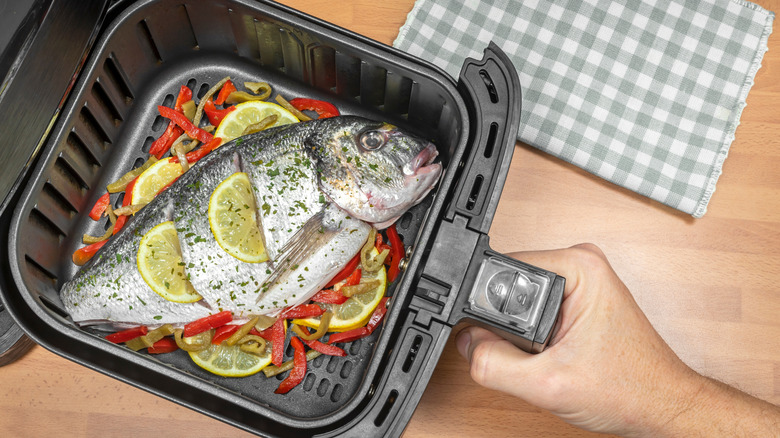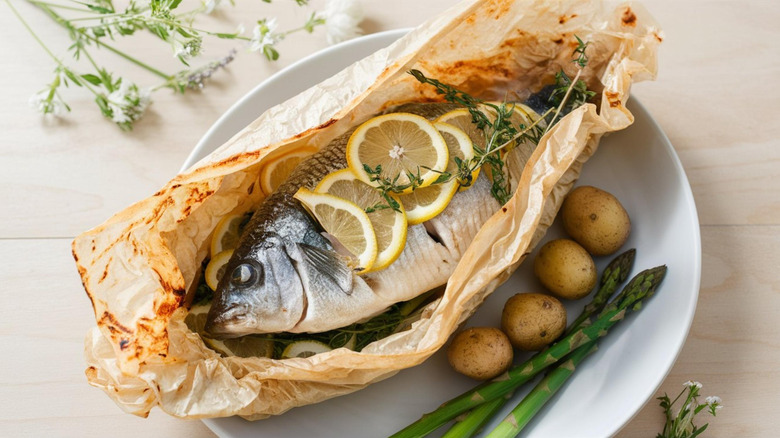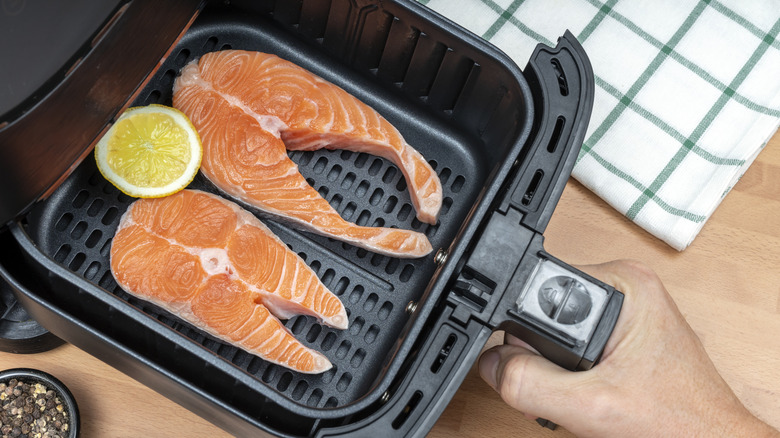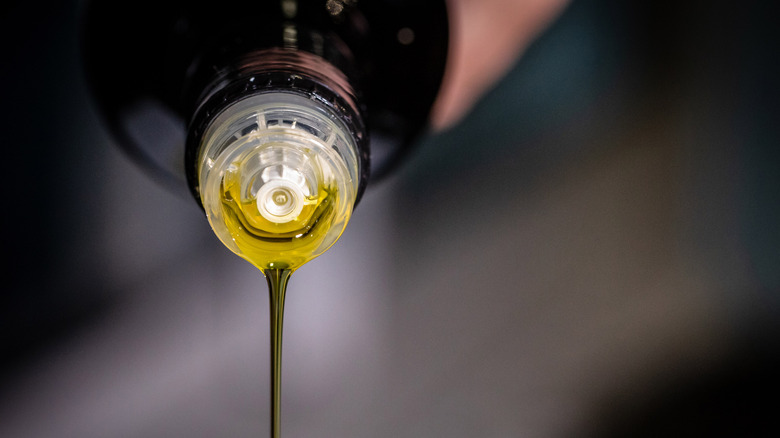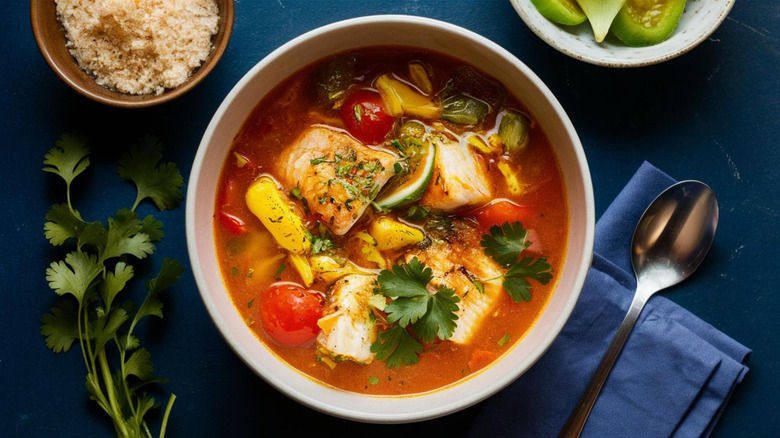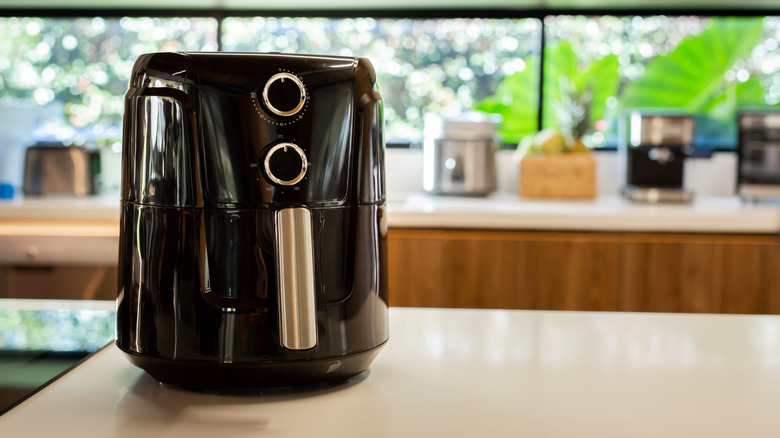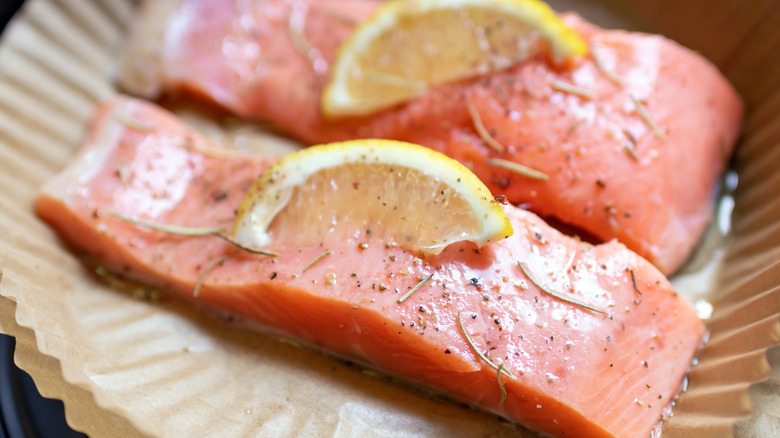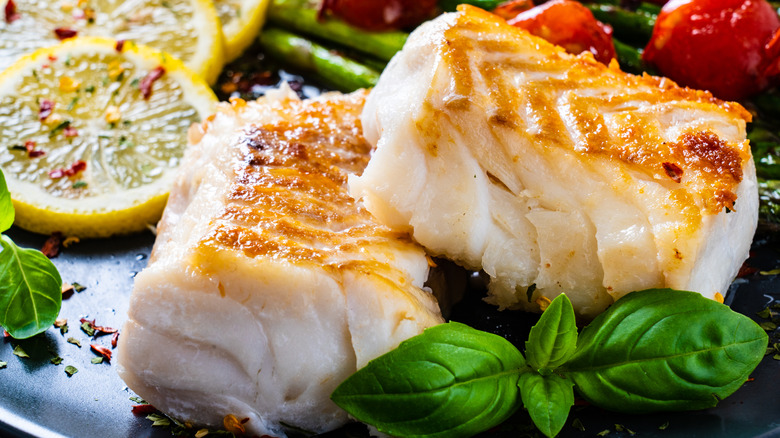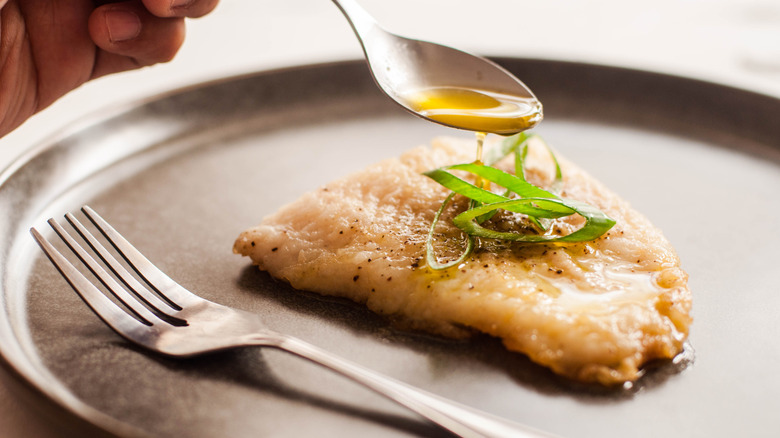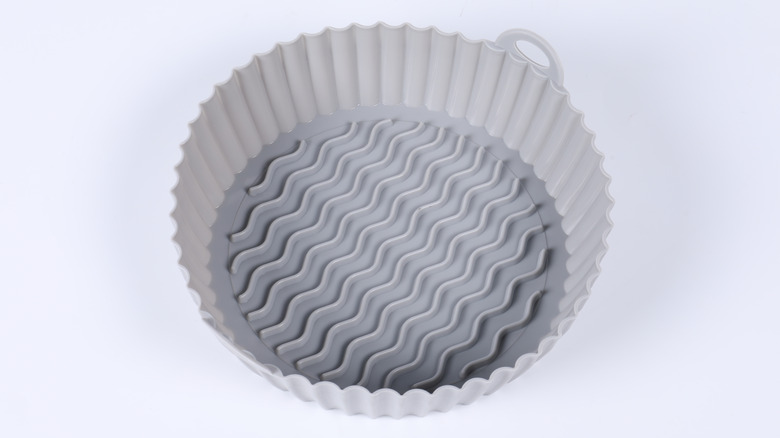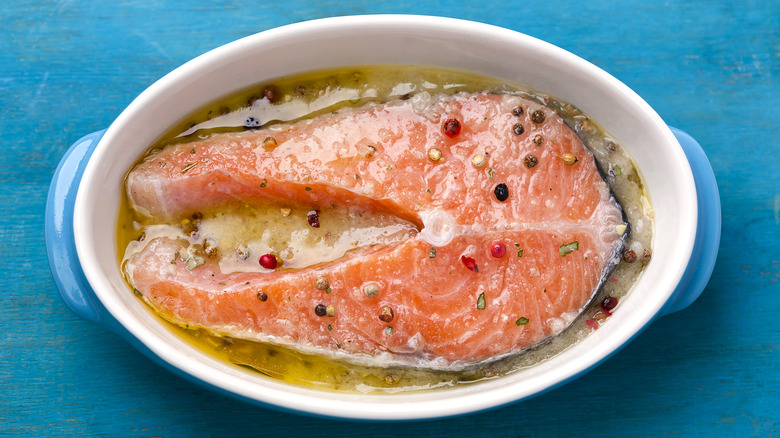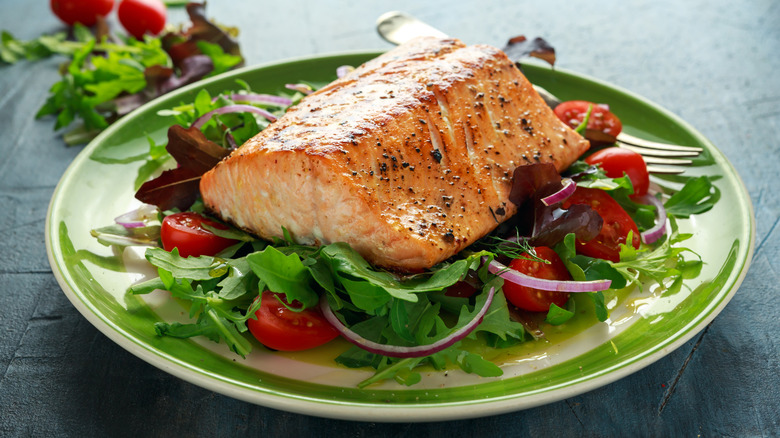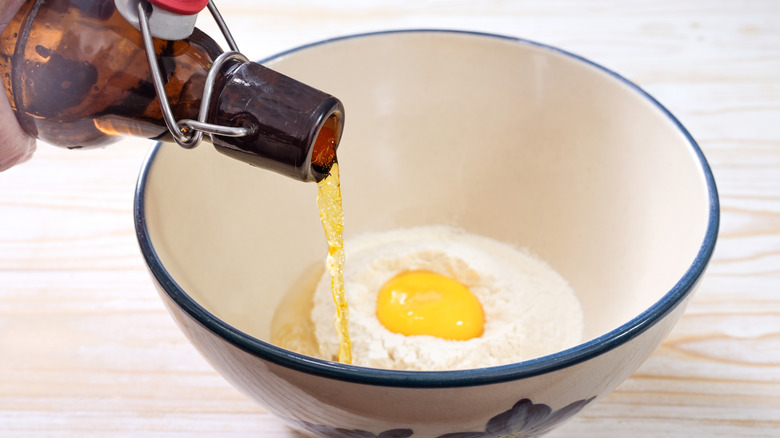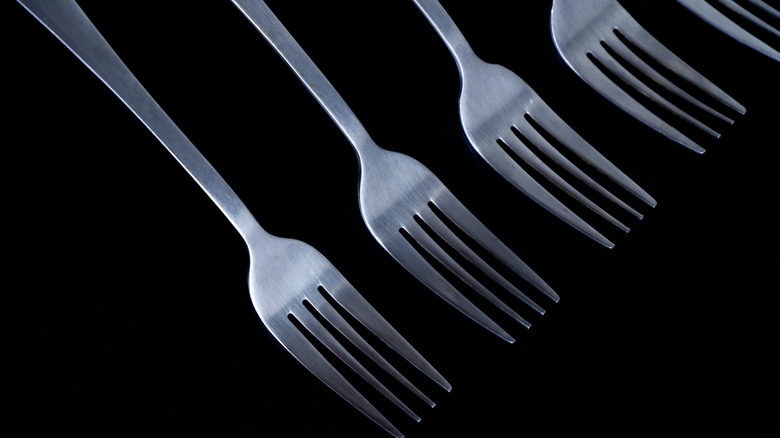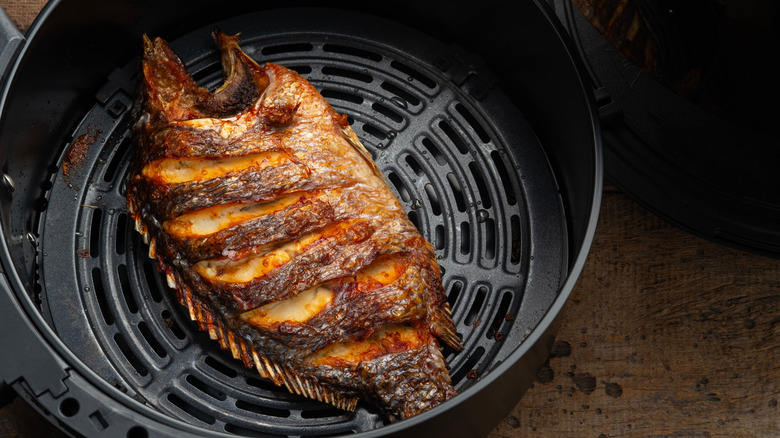14 Common Mistakes To Avoid When Air-Frying Fish
We may receive a commission on purchases made from links.
Air fryers can cook virtually any type of fish in minutes, from simple filets to full sides of salmon, and can do so with barely any mess. However, like any other type of food, getting your fish just right in your air fryer can be slightly more challenging than it looks. You not only have to be careful with your timings, but simple things like failing to prepare your fish properly or adding too much of one ingredient can ruin your meal before it's even begun.
With fish, there are two unique challenges: Its tendency to dry out and its inherent flakiness. Both of these are massive issues when it comes to the air fryer which uses dry heat to cook food, making dryness a real problem, and involves placing your food into a fairly deep basket, making pulling it out without ripping it pretty tricky. To nail this delicate protein, you need advice from the best around — so that's exactly what we got. We spoke to Clare Andrews, author of "The Ultimate Air Fryer Cookbook: One Basket Meals," to get the lowdown on exactly what you need to avoid when air frying fish.
1. Mistake: Forgetting to wrap up your fish
When people air fry fish, they tend to just plop their filets in the basket, set the timer, and wait. Now, there's nothing strictly wrong with that, but it's one of the quickest ways to dry your fish out as the convection action of the air fryer goes to work, wicking away moisture from the protein. Clare Andrews points out that fish drying out in the air fryer is a common issue, but luckily the solution is easy: Just wrap your fish up.
"The simplest solution is to wrap the fish in a tin foil parcel with a little lemon juice or white wine; this way the fish steams within the parcel," says Andrews. "It's also a great way to infuse your fish with lots of different flavors." You don't need a huge amount of moisture here to steam the fish. Because fish flesh is fairly delicate and doesn't have the density of other proteins, the steam generated by even a tablespoon or two of liquid will be enough to cook it. Covering your fish will prevent it from browning, but if you want to develop a little bit of color on your protein, pop it under the broiler for a minute after air frying it.
2. Mistake: Air-frying fish that's too thick
Everyone wants their air-fried fish to feel substantial and meaty, but you can definitely overdo things on that front. If you try to air fry a fish filet that's too thick, you may run into problems. Clare Andrews recommends trying to keep to a specific thickness for best results. "I would say the ideal size of fish filet would be around ½- to ¾-inch thick," she says. "If your fish is much thicker it can take longer to cook through, resulting in over-browning on the surface and your fish drying out."
However, you also don't want to go too far in the other direction. Trying to cook too thin of a filet in the air fryer will cause it to dry out before it even has a chance to brown. To make matters worse, thin filets can also be a nightmare to get out of air fryers without them ripping apart. If you do have a particularly thin filet, it may be worth frying it in a shallow pan instead.
3. Mistake: Adding too much fat to your fish
Adding too much fat can negate your fish's natural leanness, and leave you with fish that's greasy and lacking any delicacy. Instead, Clare Andrews recommends erring on the side of caution when it comes to fat. "You don't need to add any fat at all when you are air frying fish," she explains. "But I would suggest investing in a cooking spray, to apply a little oil on your fish. This way it reduces your fat intake, and you only need a little spray, if any at all."
Andrews also points out that adding fat to your fish may be unnecessary due to the nature of the fish itself. "Bear in mind that some fish like mackerel are naturally more oily than others." Not only does this mean that it will release fat as it cooks, but it's also something to consider when you're cleaning up after you've finished cooking. You may find that oilier fish leaves more fat in the bottom of your appliance, and if you don't get rid of it afterward your kitchen's gonna smell pretty nasty the next time you air fry something.
4. Mistake: Cooking saucy fish dishes in the air fryer
Air fryers are well-suited to most things, but what they're less capable of cooking are wetter, saucier dishes. "Air frying fish dishes with sauce can be messy," warns Clare Andrews. The issue with trying to cook saucy fish dishes in your air fryer is twofold. The first is one of spillage: If you're not careful, your sauce will drip straight through the slats in the bottom and at the sides, resulting in half of your meal pooling at the bottom of your fryer. The second is one of splatter: Wetter dishes are way more likely to bubble up and splash around your air fryer, which is exacerbated by the hot air moving rapidly through the machine.
To add to this, most air fryers are pretty small, and while you can definitely put a high-sided container or closed pot in an air fryer containing a saucy fish dish, it's kinda not worth the hassle. Instead, we'd always recommend cooking fish dishes with sauce in your regular oven or on the stove. It may take slightly longer, but you won't have to deal with so much mess afterward.
5. Mistake: Not cleaning your air fryer
Air fryers are somewhat deceptive. People tend to think that they're just like your oven, in that they don't need cleaning every time you use them. Instead, most folks think that you can get away with the odd wipe here and there, or only cleaning up when there's noticeable food waste on your machine. Unfortunately, this isn't the case.
Every part of the machine needs regular cleaning and maintenance, from replacing your air fryer's filter to cleaning the basket each time you cook something. When cooking fish, this is even more important. It's no secret that fish is one of the strongest-smelling foods out there. Failing to clean your air fryer after you cook it just allows it to become clogged up with those smells, deteriorating both your machine and the food you're cooking in it. However, if you forget to clean your air fryer before you cook fish, you can end up infusing the protein with the smells of your previous food — and because fish is so porous, this can happen very quickly and easily. Just take the time to clean your fryer, people. You'll thank us for it.
6. Mistake: Forgetting to line your air fryer basket
When it comes to cooking fish, air fryer basket liners are a must. "Lining your air fryer basket can help keep your air fryer cleaner and saves on the washing up," says Clare Andrews. When you use an air fryer basket liner, any juice that the fish releases will be kept neatly in the liner itself and not drip to the bottom. Not only that, but cooking fish using an air fryer basket liner will prevent it from sticking to the bottom of the machine. This is a huge benefit for flakier fish, which are prone to tearing when you try to remove them.
If you don't have any air fryer liners, though, you needn't worry. "You can also wrap your fish in baking paper, or tin foil, so that the juices are contained in a parcel," Andrews advises. Just wrap it up and pop it directly on the bottom of your air fryer basket. Remember to secure it tightly though, as the wind in your air fryer can loosen these packages and blow them open, allowing any seasonings on your fish to end up splattered all over the inside of your fryer.
7. Mistake: Not resting your fish after cooking it
Do you have to rest fish like you do with meat? As it turns out, yes you do, especially when you're air frying it. Just like other meats, the juices in fish are pushed to the surface and the flesh somewhat loosens up. If you don't let it rest after it's cooked, when you slice into your fish, all of those juices will spill out and leave your protein way drier. While this is more likely to happen with fatty fish with a higher moisture content, it can still happen if your fish is a little more lean.
Make sure you rest your fish after you cook it. Luckily, it won't take too much time. "I would suggest you do rest fish after removing from the air fryer, but it certainly doesn't need a long, slow rest like other meats," says Clare Andrews. "A couple of minutes resting will allow the fish to finish cooking and firm up a bit." Make sure you don't leave it for too long too, because fish can lose its temperature pretty quickly. If you're not careful, you'll end up with a cold filet.
8. Mistake: Using butter to air-fry fish
While you don't need a lot of fat to air fry fish to perfection, a touch of it is usually useful to improve your protein's flavor. For many, butter is the preferred option for fish, to give it a richer taste and a slightly creamy edge. However, when you're air-frying your fish, you should leave your butter in the fridge. Butter is a poor choice for all but the lowest settings on an air fryer, as its smoke point is exceptionally low, sitting at around 350 degrees Fahrenheit. If you're not careful, your butter will break down in your air fryer, and that smoke will then be blown out of the machine and into the kitchen.
The same thing will happen with cold-pressed oils, which can be pretty delicate and produce smoke at even the lowest temperatures. You should instead aim to use an oil with a high smoke point for your fish, like canola or corn oil. Save your butter for once your fish is done, by making a delicate butter sauce with lemon and capers and spooning it over the finished protein.
9. Mistake: Forgetting to use a vessel for flaky fish
The inherently flaky texture of most types of fish is a blessing and a curse. A blessing because it often results in a super-tender texture, a curse because it can cause the fish to break apart at the slightest touch. Unfortunately, when you're air-frying fish, this flakiness can be even more risky. Unlike a flat pan or a baking sheet, air fryers cook their food in a deep well, making it difficult to remove the fish.
That's why you should always be using some kind of vessel to cook your fish. "To prevent your fish from falling apart when you remove it from the air fryer, I would suggest cooking flakier fish in an oven proof dish or a silicone mold," says Clare Andrews. "This will make it much easier to retrieve your fish from the drawer in one piece." These vessels are also reusable, which is both less wasteful and may save money in the long run. If you don't have a reusable dish or mold, though, you can line your basket with foil or parchment paper. Just remember that air fryers cook their food via hot air circulation, so you'll want to make sure that your vessel or liner is either perforated or doesn't cover up any vents in your fryer.
10. Mistake: Over-marinating your fish
Marinating fish is a speedy way to give it way more flavor, and soften a sometimes-rubbery texture into a buttery, melt-in-your-mouth consistency. Unfortunately, though, you can really overdo it — and Clare Andrews recommends playing it safe with your marinating time. "Because seafood is delicate, you only need to marinate fish for up to an hour," says Andrews. She notes that marinating fish for too long will cause it to be over-seasoned, as well as way too moist, which can ruin both its flavor and the cooking process.
Andrews notes that even an hour can be a little too much, and "marinating fish for 15 to 30 minutes should be sufficient." Importantly, too, certain ingredients in your marinade may make a significant difference to your fish's texture. Using an especially acidic marinade can cause the protein in your fish to denature, which also occurs when you heat it — in other words, it will essentially cook it. This process is used to make ceviche, but if you denature your fish and then cook it, it'll easily end up being way too tough and rubbery.
11. Mistake: Thinking you need to flip your fish
When pan-frying fish, it's generally the done thing to flip your filets. Doing this allows you to sear your fish on both sides, generating as much browning as possible (and therefore way more flavor). Because of this, it can feel tempting to flip your fish halfway through cooking in your air fryer, to give it the best access to the circulating heat and develop a satisfying caramelized surface across the whole thing.
Tender fish like salmon don't need to be flipped at all in the air fryer. When you're pan-frying fish, you're generating a browned surface through the protein's contact with the pan; but in an air fryer, that browning is produced by the hot circulating air. If you're flipping it midway through cooking, you're disrupting the air's ability to do its job, and covering up the top layer of your fish just when it's going to start caramelizing. Plus, if you're worried about flipping your fish to allow it to cook evenly, this is really not an issue with air fryers. Because they cook food so quickly, your fish will cook in mere minutes. Pausing the cycle to flip it may hinder things more than help them, as you'll be allowing the fish to cool down when you open the basket wide to turn it over.
12. Mistake: Trying to air-fry wet-battered fish
Air fryers must have a pretty incredible PR person. We've been led to believe that these machines will give you exactly the same result that deep fryers will, without any of the fat. While that's not strictly true (air-fried food technically isn't fried), a lot of the time they can produce a reasonable crispiness and browning without plunging your food in oil — but that won't be the case if you're trying to cook wet-battered food. "Fish recipes with a wet batter can be very messy when cooked in an air fryer," warns Clare Andrews. Instead of quickly sealing the wet batter with ultra-high heat, the air fryer will instead blow the batter around before it has a chance to start crisping up — and will likely dislodge it from the fish itself. Plus, all of that lovingly made batter will drip straight off your filet and to the bottom of your machine.
However, that doesn't mean that you can't make crispy fish in your air fryer. You just have to be a little bit careful. If you're coating your fish, aim for a drier breaded coating made from panko or breadcrumbs. Ensure that they're stuck to your fish with an egg wash or a thick, sticky batter that has no chance of dripping off. Give it a light spritz with some cooking oil too, to help it brown beautifully.
13. Mistake: Forgetting to check your fish while it's cooking
Air fryers are one of the niftiest kitchen gadgets out there, partly because of their "set it and forget it" nature. You tap a few buttons, wait a short amount of time, and hey presto — beautifully-cooked food. When you're cooking fish, though, it pays to stay close to your air fryer and check it periodically. "Don't be afraid to open your air fryer drawer and check the fish," says Clare Andrews. "As each type of fish is different you may find you need to adjust the cooking time slightly, depending on the thickness of the fish." A lot of people are surprised by how quickly fish can cook in an air fryer, and if you walk away from it, you may come back to a dry, desiccated filet.
So how do you know if your fish is done? Aside from its color changing from translucent to opaque, the easiest way to tell is to stick a fork in it. Briefly open up your fryer, find the thickest part of your fish, and gently push a fork into it at a 45-degree angle. If there's no resistance and your fish flakes easily, it's ready to go.
14. Mistake: Overcrowding your air fryer with fish
Air fryers can become challenging when you're cooking for more than a few people. Their baskets tend to be quite small, making getting a lot of food in one go pretty tricky — and it's a good idea not to try and force things. Overcrowding is one of the most common air fryer issues, and it's a particularly big no-no with fish. When you shove fish filets in next to each other with no space in between, the air can't circulate around them properly. This will cause them to cook unevenly, and potentially leave some of your food raw.
Always ensure that there's a good centimeter or two between each piece of fish in your air fryer. This will allow them to brown evenly and ensure that the heat gets into every corner of the protein. Make sure you don't stack them on top of each other, either; stick to one layer at a time.
